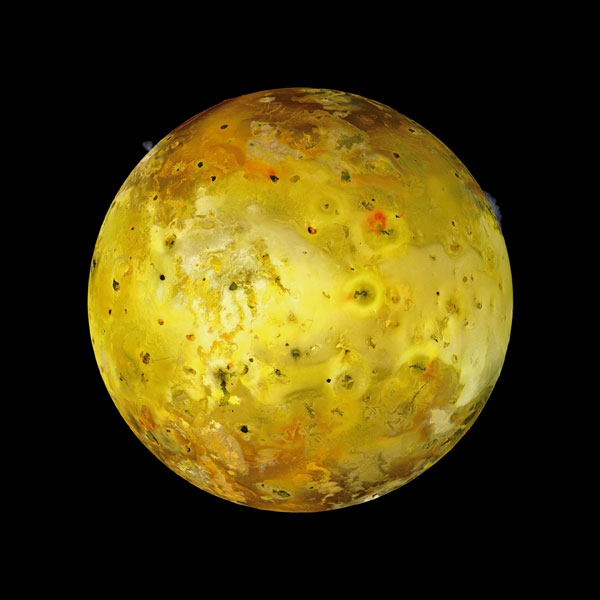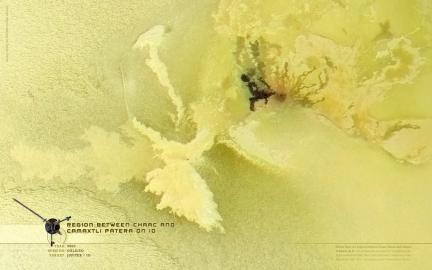From processor Ted Styrk, “The Juno Jupiter orbiter flew by Io, Jupiter's super-volcanic moon, on May 16, returning arguably the best imagery of the moon since the Galileo Orbiter around the beginning of this century. Definitely the best since New Horizons in 2006.”
Image Courtesy of NASA/JPL-Caltech/SwRI
Kind of Cool Image of Io from Juno
The brightest spot is a radiation signature, but all the rest are thought to be active volcanos on the Io surface. The moons are not a primary target of the Juno mission, but they do occasionally take a peek to try and monitor such phenomenon at Io. Later when the mission is extended, Juno will explore the full Jupiter system with its rings and moons. Multiple rendezvous are planned for Ganymede, Europa, and Io.
Image is not visible light, but taken with an x-ray camera.
Cyber Tuesday Spaceprobe Deal
 For two days only, buy one of our limited edition Robotic Spacecraft Series Prints and get the full suite of vinyl stickers for free. This is a total savings of $24 and would serve as a great stocking stuffer to follow the presentation of the print.
For two days only, buy one of our limited edition Robotic Spacecraft Series Prints and get the full suite of vinyl stickers for free. This is a total savings of $24 and would serve as a great stocking stuffer to follow the presentation of the print.
Historic Robotic Spacecraft Poster Survey
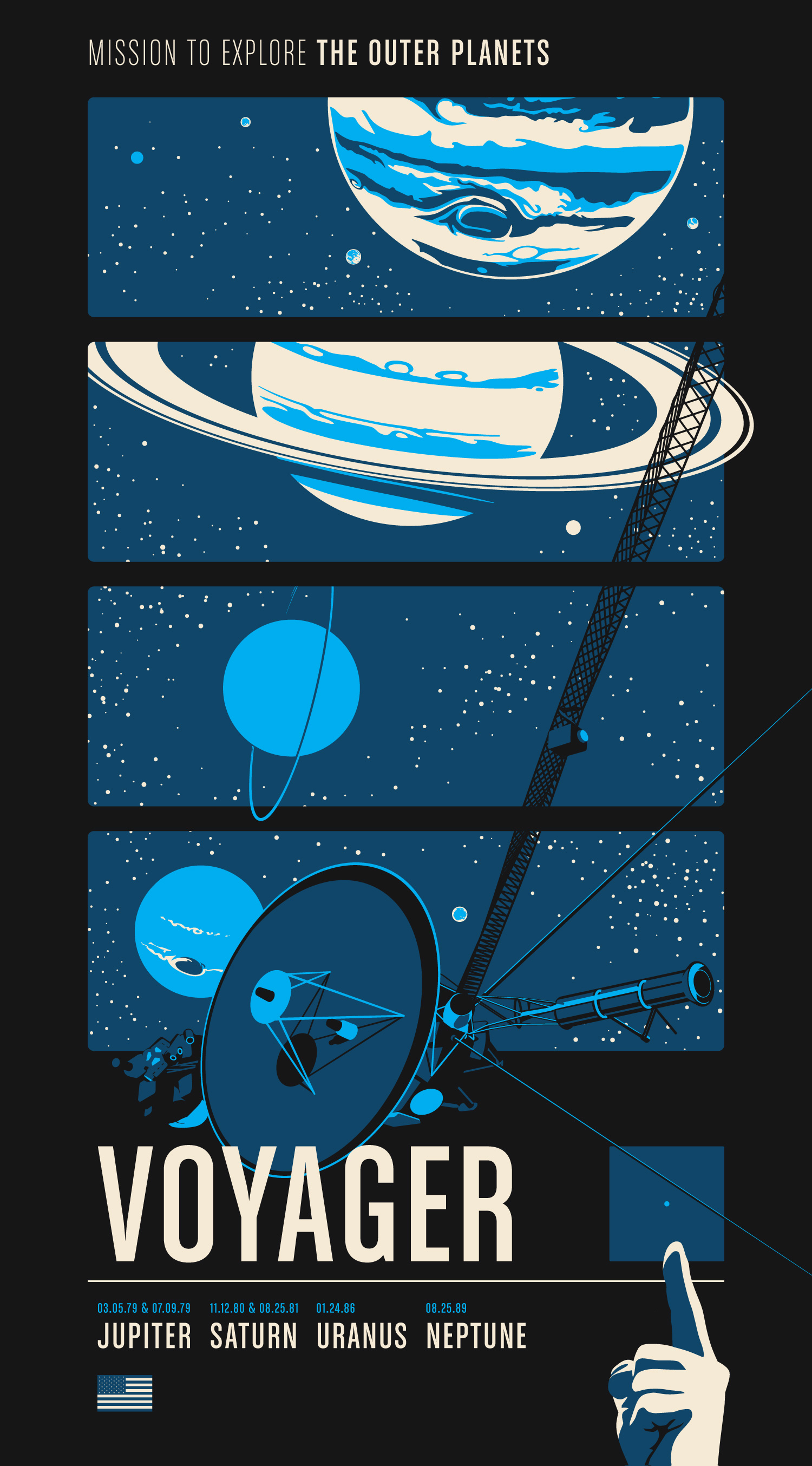 Our new Kickstarter project proposes the creation of three screen-printed posters celebrating the most popular and notable interplanetary robotic space missions in history. Going into this, we knew that poster #1 had to go to the hugely popular Voyager missions (shown above). However, we need your help selecting the themes of posters #2 and #3. So head over to The Planetary Society now to vote on your three favorite missions, but do it by the 19th to have it count for the poster selection. If this goes better than expected we could even wind up designing a fourth or fifth.
Our new Kickstarter project proposes the creation of three screen-printed posters celebrating the most popular and notable interplanetary robotic space missions in history. Going into this, we knew that poster #1 had to go to the hugely popular Voyager missions (shown above). However, we need your help selecting the themes of posters #2 and #3. So head over to The Planetary Society now to vote on your three favorite missions, but do it by the 19th to have it count for the poster selection. If this goes better than expected we could even wind up designing a fourth or fifth.
Bjorn Jonsson’s Massive Voyager Composite
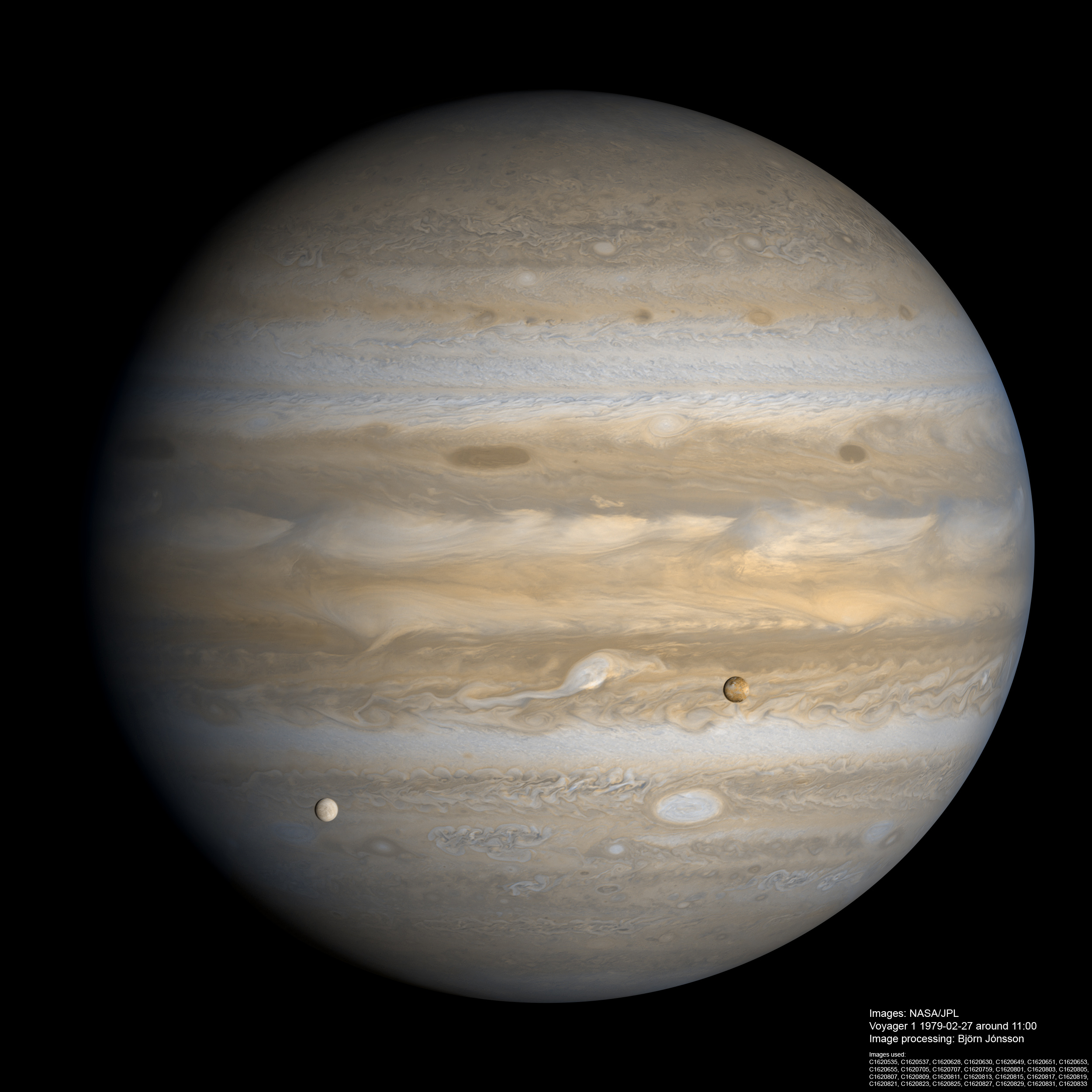 Stunning hi-res composite of Io and Europa transiting the mighty disc of Jupiter. Three of the most fascinating bodies in the solar system in one highly detailed image. You MUST click on the full resolution to see the details that are even apparent on the moons.
Stunning hi-res composite of Io and Europa transiting the mighty disc of Jupiter. Three of the most fascinating bodies in the solar system in one highly detailed image. You MUST click on the full resolution to see the details that are even apparent on the moons.
Created by Bjorn Jonsson.
Planetfall
Having followed the activities of a small army of freelance space imagers that lurk in various places on the internet for about 10 years now — it is truly unusual for me to come across images that I know I have not seen before. Michael Benson’s exhibit titled, “Planetfall” at the American Association for the Advancement of Science offers offer fresh views from missions as old as Viking and as new as Cassini. What originally caught my attention was an image of an actively spewing Enceladus that is exposed in both Sun and Saturn shine — a view I have surely seen before, but never so detailed or dramatic. Even more surprising and rare is a new global composite view of Uranus with a complete and continuous ring taken by Voyager almost 30 years ago.
The show ends soon (June 28, 2013) and is located in Washington DC.
You Are the Center of the Solar System
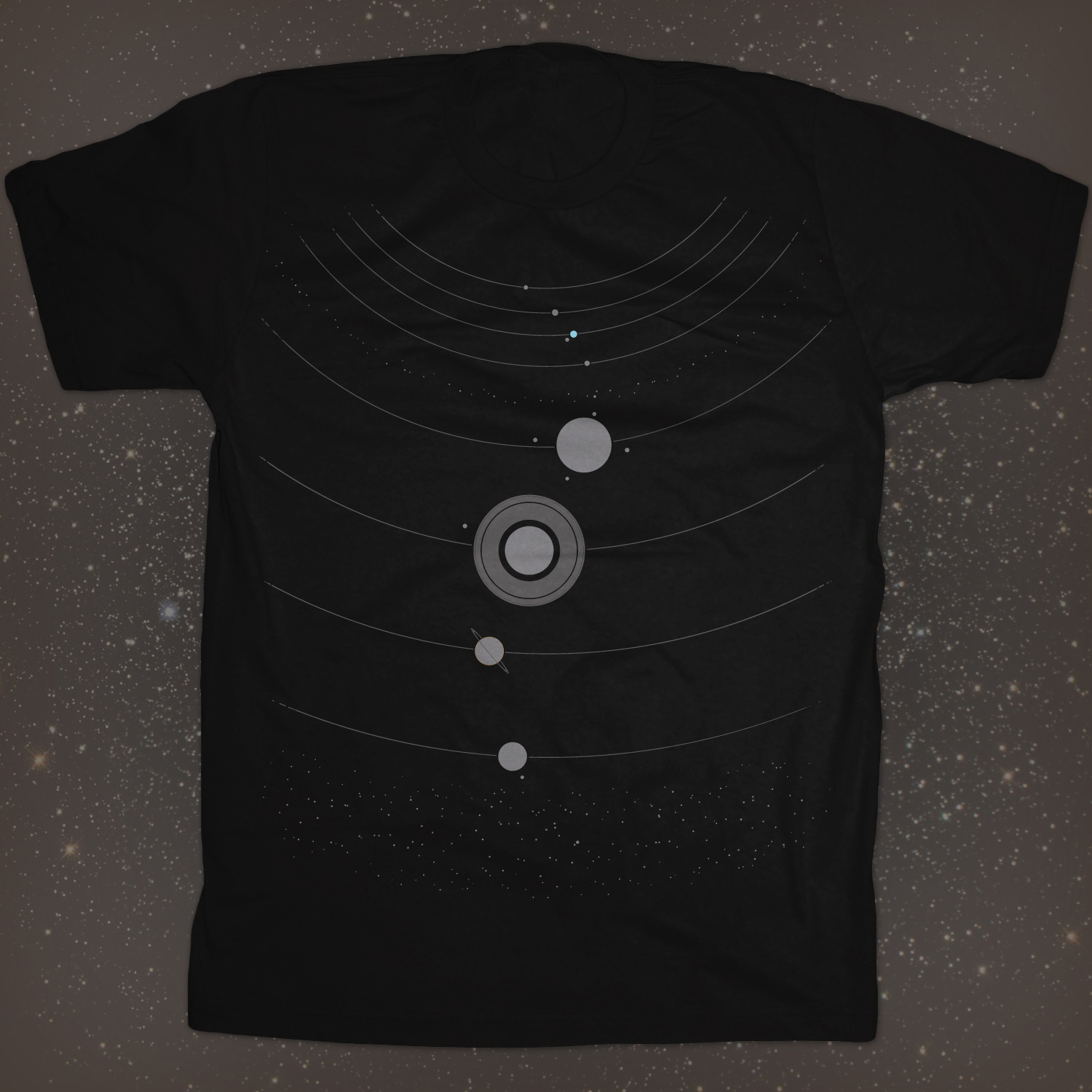 You Are The Sun is the latest space themed tee by Chop Shop Store. Following on iconic tees that collected various deep space missions and historic Earth orbit missions, this new design draws a new picture of The Solar System as we know it today, complete with Carl Sagan’s pale blue dot.
You Are The Sun is the latest space themed tee by Chop Shop Store. Following on iconic tees that collected various deep space missions and historic Earth orbit missions, this new design draws a new picture of The Solar System as we know it today, complete with Carl Sagan’s pale blue dot.

With your head as a stand-in for The Sun — the tee includes all 8 planets, 7 major moons, The Asteroid Belt and even details little Pluto lost among countless Kuiper Belt objects. We are now providing yet another link here to get it for Men on American Apparel 2001 or Tultex tees and for Women on American Apparel 2102 tees.
Io & Europa Image Upgrade
We posted a similar image of an Io and Europa mutual event from the New Horizons mission a few years back when it zipped past Jupiter on its long journey to Pluto. Our hero of freelancer image compositing Gordan Ugarkovic now presents to us a much better view.
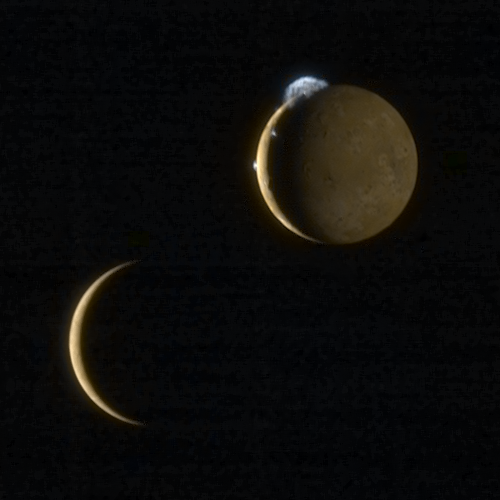
I count at least 4 if not 5 active eruption on Io in this version. The level of detail improvement from the same encounter is amazing. Old missions keep getting newer.
Schenk’s House of 3-D Moons!
Paul Schenk has been taking new and old data from missions to the various moons of Jupiter, Saturn, Uranus and Neptune and building 3-D models of what it might be like to fly through some of their more fascinating features. These are renders built from actual images, so often you might see areas of lower resolution due to a lack of better mission data. The one posted above of Hi'iaka Montes on Io is one of the best on his youTube page as the data available from the region is mostly in high resolution with few gaps.
50 Years of Space Exploration Map
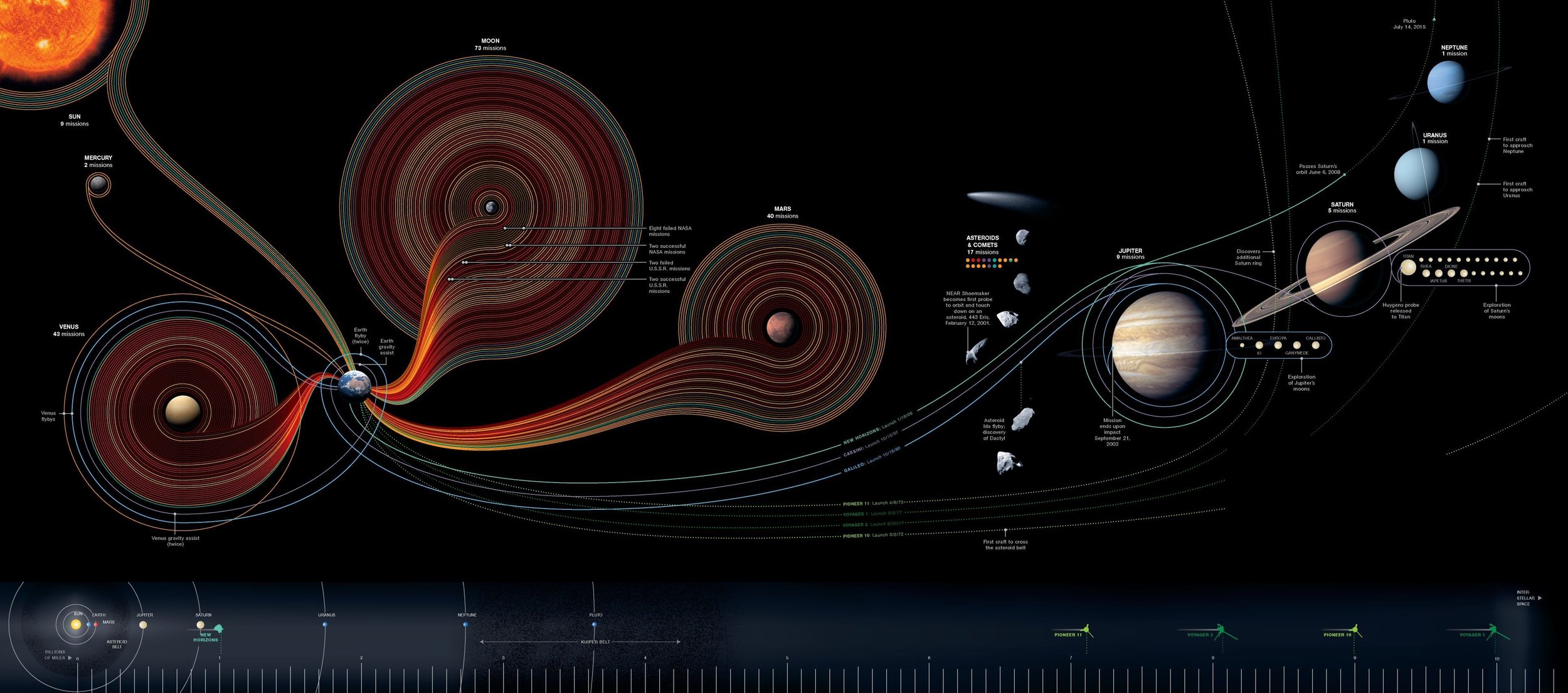 This is so nice, but I am furious that I didn’t get to design this. This is Information design at it’s best naturally by National Geographic. You can see 50 years of robotic planetary exploration at a glance. It even includes failed missions represented by darker desaturated lines. As far as I can tell the cream colored lines are US and the red ones are Soviet. Interesting to see how many of those lines go dark around Mars.
This is so nice, but I am furious that I didn’t get to design this. This is Information design at it’s best naturally by National Geographic. You can see 50 years of robotic planetary exploration at a glance. It even includes failed missions represented by darker desaturated lines. As far as I can tell the cream colored lines are US and the red ones are Soviet. Interesting to see how many of those lines go dark around Mars.
Now where does one purchase such a thing? Perhaps this month’s issue of NG? Here is the link to it on their site complete with zoom viewer and them some kind samaritan posted a hires version to flickr.
Galilean Family Portrait
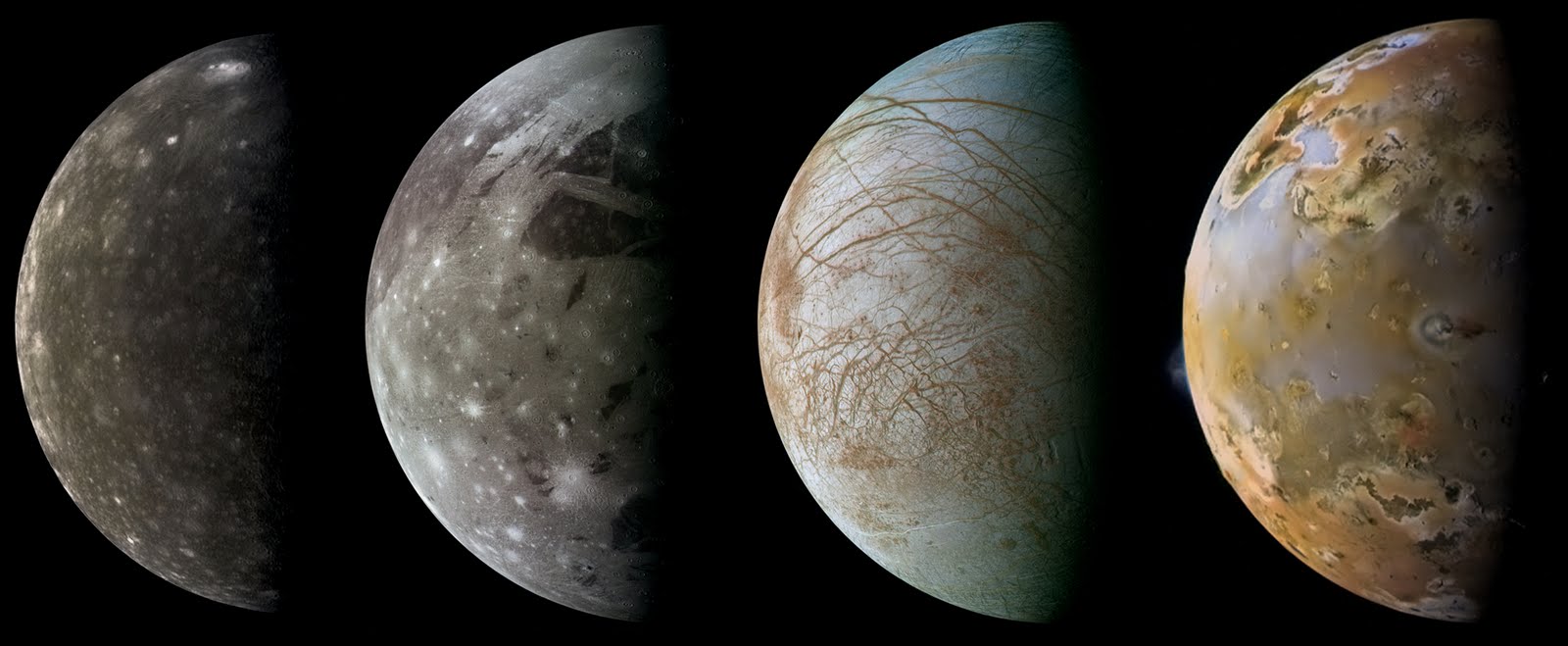 I usually do not go for montages of planets for a variety of reasons, but this family portrait of the 4 Galilean moons of Jupiter is quite gorgeous. They are easily the most fascinating and beautiful bodies of our system of worlds, save for perhaps Saturn and its rings.
I usually do not go for montages of planets for a variety of reasons, but this family portrait of the 4 Galilean moons of Jupiter is quite gorgeous. They are easily the most fascinating and beautiful bodies of our system of worlds, save for perhaps Saturn and its rings.
Another work of art by Ted Stryk whose old blog Planetary Images from Then and Now has come back from the dead with vigor!
iPhone Skins Featured on feulyourcreativity.com
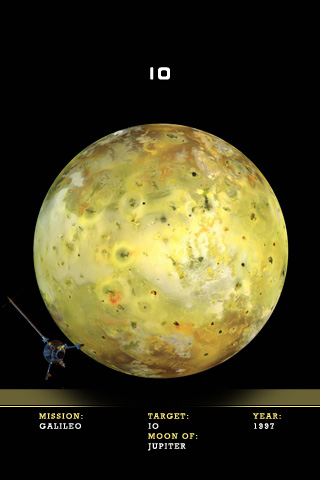 Not to re-post old material, but our iPhone planetary skins were recently posted to fuelyourcreativity.com for free download. So I thought I would just remind everyone and maybe direct a little traffic love their way.
Not to re-post old material, but our iPhone planetary skins were recently posted to fuelyourcreativity.com for free download. So I thought I would just remind everyone and maybe direct a little traffic love their way.
Friend a Moon on Facebook
 It is true. You can become friends with all the best moons on Facebook these days. Who wouldn’t want to get closer to Io. Maybe get to know better Jupiter’s moon Europa. Maybe you live in the same Solar System as Enceladus?!
It is true. You can become friends with all the best moons on Facebook these days. Who wouldn’t want to get closer to Io. Maybe get to know better Jupiter’s moon Europa. Maybe you live in the same Solar System as Enceladus?!
Outer Planets Mission Selected
 It is final. NASA (and ESA) have selected the next flagship mission to the outer planets. The target is the Jupiter system, and by “system” I do mean system. NASA’s side of things will concentrate on a Europa orbiter which will observe Jupiter’s moon in details that we have never seen before. See this youTube video for a good overview. The last time we were near Europa enough to make close observation was with Galileo, but problems with that spacecraft resulted in a limited amount of data that one would expect from such a long orbiter mission such as Galileo.
It is final. NASA (and ESA) have selected the next flagship mission to the outer planets. The target is the Jupiter system, and by “system” I do mean system. NASA’s side of things will concentrate on a Europa orbiter which will observe Jupiter’s moon in details that we have never seen before. See this youTube video for a good overview. The last time we were near Europa enough to make close observation was with Galileo, but problems with that spacecraft resulted in a limited amount of data that one would expect from such a long orbiter mission such as Galileo.
Beyond Europa, the mission will also be close enough to do great observations of its closest neighbor, Io, as well – of course – as it’s host planet Jupiter. Also worth noting is the possible adoption of an Io specific orbiter as part of the New Horizons class of spacecraft whose targets for the next decade have yet to be determined.
Lastly, and certainly not at all a small thing… ESA will be running a Ganymede orbiter to work in tandem with the Europa mission. The two missions are more like partner missions such as the 2 Mars rovers than separate ones. They seem to planning for them both to arrive at the same time (or even launched from the same rocket, is that even possible?).
For those unfamiliar with these bodies, check out these links to other posts about Europa and Ganymede.
Moons of Jupiter on Your Desk
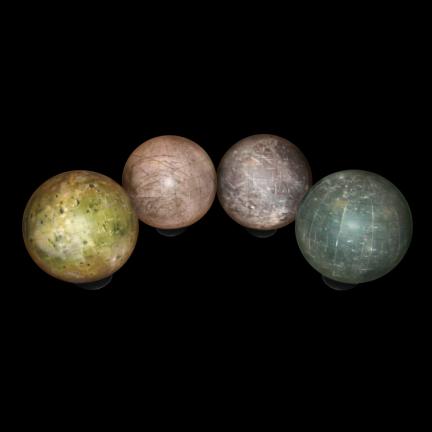 Download this pdf to check out these soon to be produced desktop globes of Jupiter’s moons and contact them about any interest in buying them here. These are cardboard-substrate globes on simple plastic bases, but they still look pretty cool. Even at the high price of $300 (a pre-production estimate) – I have to say that I am pretty tempted.
Download this pdf to check out these soon to be produced desktop globes of Jupiter’s moons and contact them about any interest in buying them here. These are cardboard-substrate globes on simple plastic bases, but they still look pretty cool. Even at the high price of $300 (a pre-production estimate) – I have to say that I am pretty tempted.
Volcanic Io Wallpapers
Io and Amalthea Portrait
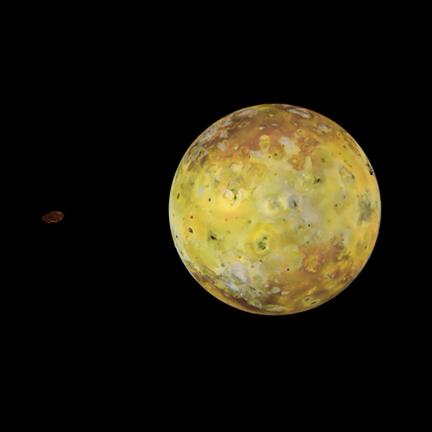 A rare view of Io and the small moon Amalthea seen in the same view was taken by Galileo and recently reprocessed by Ted Stryk (his page is linked lower right). Amalthea is a tiny elongated moon that appears to be quite red. It is assumed that the longish shape and red hue come from the deposit of materials ejected off Io and spiral inward to Jupiter, swept up by Amalthea in its orbital path.
A rare view of Io and the small moon Amalthea seen in the same view was taken by Galileo and recently reprocessed by Ted Stryk (his page is linked lower right). Amalthea is a tiny elongated moon that appears to be quite red. It is assumed that the longish shape and red hue come from the deposit of materials ejected off Io and spiral inward to Jupiter, swept up by Amalthea in its orbital path.
A similar phenomenon has also been seen at Saturn with moonlets that “sweep” ring materials.
Wallpaper: Io’s Prometheus Volcano
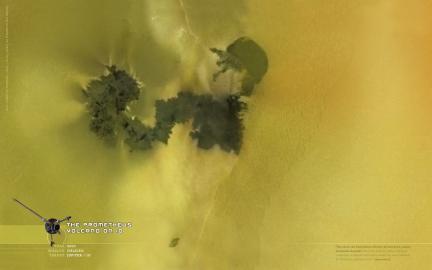 Jason Perry has been featured here a whole bunch lately as he has been uploading newly processed Galileo images nearly every week (not to mention the recent New Horizons set). Some of these images would make great wallpaper displays, but the only issue with some are missing data regions and the noise that is common with hires images from the Galileo mission. Wanderingspace has attempted to artistically replace and clean of few of these images and will be posting the results of these for the next few days.
Jason Perry has been featured here a whole bunch lately as he has been uploading newly processed Galileo images nearly every week (not to mention the recent New Horizons set). Some of these images would make great wallpaper displays, but the only issue with some are missing data regions and the noise that is common with hires images from the Galileo mission. Wanderingspace has attempted to artistically replace and clean of few of these images and will be posting the results of these for the next few days.
The region shown is the most famous of Io’s active volcanoes Prometheus. Normally we see this volcano at the edge of Io’s limb to view the plume clearly on profile, but here Galileo views this very active region from above during a flyby on orbit #27. The reddish haze surrounding the area is either the plume itself jettisoning materials or could also be deposits lying on the ground – perhaps Jason will comment and clarify.
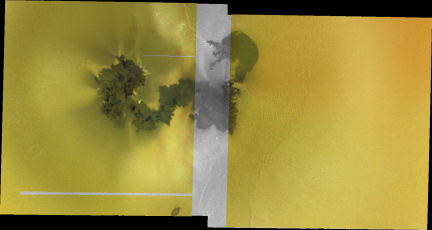
The above image is the Jason Perry original and the missing color information is apparent (only the green channel was provided from the mission). The noise at this scale is less apparent but much more visible on the hires version. It is important to note that the wallpaper version is an artistic attempt at cleaning and replacing the missing data and is meant for display viewing not science!
IMAGE NOTE: As stated above – the missing color data was colorized in the region it was missing and some of the thin strips of missing color data was simply replaced with new image information. You can also see areas at the edges of the composition that were filled with duplicate image data to fill the wallpaper frame most notably at top right and bottom left. The remainder of the image is original except for the noise reduction provided by Photoshop.
More New Horizons Io Images
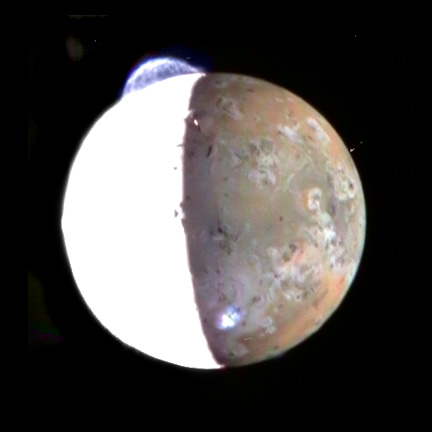 The reason the left side is so blown out is due to the fact that the image was overexposed for Jupitershine and New Horizons cameras were designed for low light at Pluto which is ideal for observing the moons of Jupiter by light reflected off their host planet. However, doing this results in the total overexposure of the side lit by the Sun.
The reason the left side is so blown out is due to the fact that the image was overexposed for Jupitershine and New Horizons cameras were designed for low light at Pluto which is ideal for observing the moons of Jupiter by light reflected off their host planet. However, doing this results in the total overexposure of the side lit by the Sun.
This is another Jason Perry image and the original can be found here. Wanderingspace simply removed the lens flare noise and the overexposed color noise. He just added some New Horizons Io images that he has personally reprocessed on this page.
Fun With Io
Jason Perry’s most excellent Io blog (who would have ever expected there would be an Io blog one day) is loaded with his finely reprocessed Io images from the historic Galileo mission. Some of the more dramatic images were only captured in monochrome (that is black and white to most), so I thought I might try and colorize one of these images just for shits and giggles.
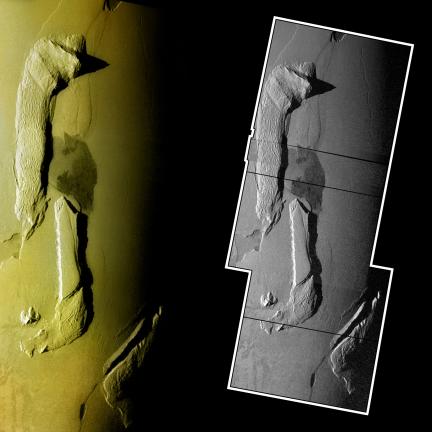
The image is that of Hi'iaka Patera and two nearby mountains (taken in 1999). The tallest peak is about 11 kilometers high. The dark features are usually thought to be calderas, however the dark regions here could be depressions that were later filled by dark lava flows. Galileo took the images at from about 26,000 kilometers.
The colorized image is merely an artistic impression. You can see where missing data has been “filled” in with texture by comparing the two images and seeing where the composite left gaps. The color information is wholly interpretive and based upon colors that appear in many other Io images but are not at all matched up to the region specifically. The real image was processed by Jason Perry and the original image is located on his page of Galileo Io images from orbit 25.



